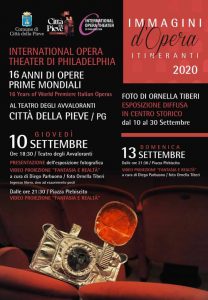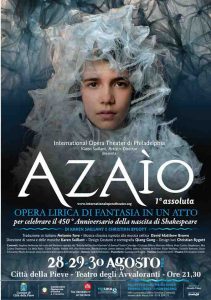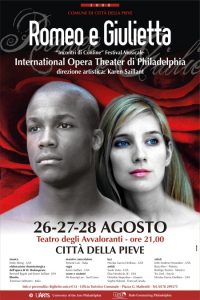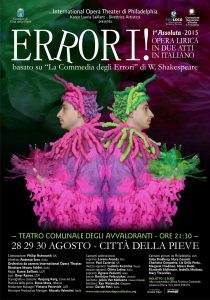Every summer for the last 16 years, the picturesque town of Citta’ della Pieve, (located between Rome and Florence) has hosted Karen Lauria Saillant’s opera festival where guests were treated first-hand to beautiful world premiere Italian operas; a staggering 16 operas in 16 years.
However, due to COVID-19 restrictions, the structure of the 17th world premiere Italian opera had to be changed, because Saillant is not permitted to travel to her beloved “second home” in Italy, where actor Colin Firth and musician Ed Sheeran have homes.
Finding a creative outlet during a global health pandemic is no easy feat, but it is something that opera and arts lover Saillant is able to accomplish with great aplomb, especially with the creative genius of her beloved Italian town. So much so that they are celebrating 16 years of creating remarkable works of art that are ceremoniously praised around the world.
Her cultural collaboration, passion for the arts, and inability to give up on even her most lofty creative endeavors are truly unique, as is her story, which involves a glorious tribute: ′′Traveling Opera Images 2020,” taking place from Sept. 10 to Sept. 30.
Saillant, a loving mother of two grown sons, was raised in the Philadelphia foster care system in which she faced many emotional difficulties. She didn’t meet her biological mother until age 13 and met her father as an adult. Yet, despite these humble beginnings she grew up to be an opera singer and is now a distinguished opera director in Italy and Philadelphia. When her beloved husband was in a coma for a year and a half, she compassionately cared for him in the living room of their home and learned the power of unspoken language. All of these experiences have informed her creative process.
After performing in regional opera houses in Italy and the U.S., in 2003 she founded International Opera Theater a Philadelphia-based nonprofit, where she has continued to nurture her passion for art and life, and spread this cultural joy in the U.S. and abroad.

Saillant’s story is a celebration of not only Saillant, but scores of Philadelphia-area children, costume makers, set and lighting designers, librettists, composers, educators, and families, in addition to artists from 75 plus countries who have taken this extraordinary journey with Saillant, fueling our collective love for opera, and arts.
In fact, more than 70 local children have performed in 11 of the operas, raising their sweet voices in Italian after instruction from Saillant and native Italian professors here in Philadelphia and in Italy. Their parents credit Saillant for giving the gifts of opera, music, and the arts to their children, starting a life-long love for the arts and culture, while at the same time building their confidence.
One of her collaborators is another unique artist, Mi-Kyoung Lee, the Head of the Fibers program at the University of the Arts, who has designed costumes and sets for many of the 16 operas, and was joined by her proteges and UArts interns in these projects. Other interns have come from UPENN, Rowan University, Drexel University, and dozens of other notable universities throughout the US.
For the first time, this local Philadelphia opera director, as a way to pivot during COVID-19, will have excerpts from her 16 years of world premiere Italian operas brought into our living rooms, coordinated with love by the Italian town where her new operas have premiered.
What Saillant strongly believes is of significant importance is to consider how transformative opera, music, and the arts are to those who participate, as well as those who witness a performance.
While this year Saillant can’t physically be in Città della Pieve, tradition must triumph over any and every obstacle set in its place, and, as in all the great love stories, if one of them can’t take a step, the other will meet him and shake his hand.
This year, therefore, the picturesque town of Città della Pieve, will return all the affection and dedication received by Saillant in all these years with a tribute: ′′Traveling Opera Images 2020,” in which the stages will be retraced of the work done to date by International Opera Theater, through the photos of Ornella Tiberi and the creativity of videographer, Diego Parbuono and designer, Francesca Tiriboco, a musical and photographic journey, taking place from Sept. 10 to Sept. 30, along the streets and windows of the old town.
Compilation audios, with photographs from Saillant’s operas performed in Citta’ della Pieve over the past 16 years will be incorporated throughout the Italian town from Sept. 10 through Sept. 30 via opera worn clothing displayed in various store windows, photographs from opera productions with QR codes in the storefront windows that can be viewed by the Italian city locals, as well as Philadelphia natives and those throughout the world via YouTube.
Karen Lauria Saillant took some time to talk to PCM about her many passions:
What do you believe audiences get from attending the opera?
When the artists performing are in harmony with nature, then the audience experiences catharsis and the expansion of their frame of reference. I believe that the audience comes into the theater, and they have an experience that when they leave, has changed their world view. This opens audience members to new ways of thinking. The great powers of music, theater, art, and opera truly expand our frame of reference. This is about an extraordinary expression of communication that goes beyond speaking.
Why is all of this so vital?
The future of world peace is in the hands of our children. The opportunity to not just see an opera, but to be part of the creative process in harmony with nature — in a town that retains its connection to the roots of Italianita’ — that is a powerful experience. Opera was created during The Renaissance, in Italy, not far from our town. Opera was believed to have the power to heal their tainted society. These children who sang in front of Italian audiences had never spoken Italian before they participated in one of my operas.”
What effect did this have on their parents?
The parents felt their children were transformed by this experience. We need people to understand that this is not some frivolous activity. Instead, it can be powerful for character building and the potential for healing. In ancient China, one of music’s earliest purposes was for healing, as it was believed that music had the power to heal the heart, enrich the mind, and harmonize a person’s soul. The Chinese character for “medicine” (藥 yào) stems from the character for “music” (樂, yuè). I liken it to the original symbol for medicine in Chinese, within that is also a symbol for music because it is a cathartic experience for healing and we need that, especially now.

Why are so passionate about the arts? Why does all of this mean so much to you?
It is natural to me, from the time I was a child, I was always singing, dancing, and creating.
Please tell me about how all of this deepened later in your life.
After my son and I were attacked by a homeless person my husband came to our rescue and he had no pulse for 27 minutes. He was revived, but remained in a vegetative coma until his death.
What was the life lesson here?
That we need more compassion in our world. Tragedies occur as a result of misunderstandings. Many of our operas have social justice themes, starting with Shakespeare.
You are so devoted to and so in love with opera. Tell me about this?
Opera combines, all of the art forms: dance, theater, music, poetry, prose, fine arts, and architecture. In my opinion, opera is the most complete art form. I believe it has the power to heal. If the artist is able to be in harmony with nature, using their body as an expressive element and conduit for non-verbal communication, creating pictures, and self-organizing on the stage, then the audience is able to witness the harmonious interactions of the stage performers and they become inspired, unconsciously, to go into the world and live a more harmonious life.
 How did being in the foster care system inform your life and art?
How did being in the foster care system inform your life and art?
I aged out of foster care at age 18. I was never adopted. I was lucky because many foster children end up in prison and that did not happen to me. But, as an outsider, I lived through a lot of conflicts, and a lot of emotional problems. In those days, social workers were not as actively involved with foster families and their children as they are today. Parental threats and brutal punishments were a part of my daily life. It was a fear-based childhood. I believe that this created a lot of sensitivity, and to this day, I utilize this in my understanding of arts and people.
It may have started from fear but it allowed me to develop a vibrant imagination. I would make up stories about my real parents. I met my real mother when I was 13 and my real father at age 52. Before meeting my mother, I had a whole imagined history that I had created about who my parents were and why they gave me up.
Please tell me more.
My foster sister was paralyzed and my foster father was missing fingers on his hand, so it was difficult when my handicapped father or sister would come to school. That helped with my sensitivity and empathy, as well as appreciating sacrifice and suffering in others. Even though it made them short-tempered I believe that part of my survival mechanics was being empathetic. Empathy and compassion and understanding are important parts of being an artist and a human being.
I know you are proud of all of your operas, but tell me about an experience that was not operatic that really touched you?
I went to Italy for the third opera and I did a theater piece with a group of severely handicapped young people in Umbria, Italy, after spending a year and a half with my husband. Only one of these young people could follow directions. Their parents sobbed when they saw their teenagers create a work of theater. It was a great triumph. I was able to create a theatrical event that celebrated the characteristics that had been considered aberrant of the teens in the show. I validated the behaviors that set them apart, rather than making it a problem, I made it an asset. That made each family really cry because in life we all need validation and they saw before themselves, on that stage, their sons and daughters having that much-needed support.
How did caring for your husband continue to impact you?
One of the keys to understanding this is in a process that revealed itself to me after caring for my husband. I was to stumble upon the validation of this experience in a book which the famed Australian conductor, Sir Charles Mackerras, called it ausstrahlung which means emanations or charisma. It involves the ability to share large bodies of information that are passed on quickly and can be communicated non-verbally through your energy. That communication is essential for a performing or directing artist.
Finally, what should we know about arts and culture in your view?
I believe that music is far more than what is written on paper. As a conductor, I had to be able to communicate beyond speaking and the written music. I’ve developed exercises so that I can create an opera in one month, complete with orchestra, staging, and costumes. To be cathartic there has to be expansion and change, then you know you are in the presence of a beautiful work of art. In the end, it has such a beautiful benefit because we all have the ability to communicate in these ways with one another. We have these extraordinary abilities from the moment we are born. If we want world peace these abilities must be encouraged and allowed to develop. They must be heightened and strengthened. How can we do this? Art is the answer.
Please check out: https://www.youtube.com/user/internationalopera


